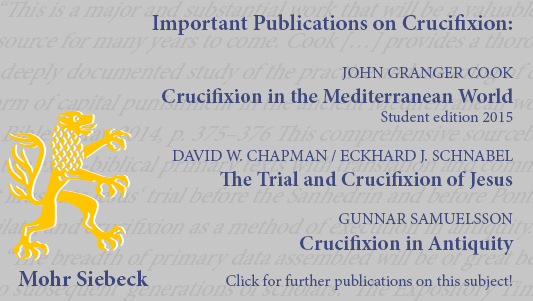The concept of crucifixion seems straightforward enough, but is “crucify” a correct translation of σταυρόω? For what were people crucified, and when did this punishment arise? Did it occur in the ancient Near East, or in the Roman Empire prior to Jesus? How do the Latin terms crux and patibulum relate to the Greek noun σταυρός? If you thought this whole crucifixion thing was straightforward, meet these three WUNT monographs from Mohr Siebeck that will unsettle you… or maybe not.
Chapman and Schnabel’s The Trial and Crucifixion of Jesus (WUNT 344), John Cook’s Crucifixion in the Mediterranean World (WUNT 327), and Samuelsson’s Crucifixion in Antiquity (2nd ed., WUNT II/310) together provide all the historical and linguistic investigation you could ask for on crucifixion in the ancient world and Jesus’ trial and crucifixion, in particular.
The Trial and Crucifixion of Jesus
Chapman and Schnabel’s work is a researcher’s dream. They pull together the majority of primary texts relevant for the trial and crucifixion of Jesus, together with commentary. At an impressive 754 pages, this work is a labor of love.
The primary texts are given first in their original language, followed by a translation, and accompanied by commentary on critical issues in the text. The texts divide into three parts: (1) trial before the Sanhedrin; (2) trial before Pontius Pilate; (3) crucifixion. If you want to understand how Jewish or Roman trials were executed, or what crucifixion was like in the ancient world, this book brings together the primary sources you need with illuminating commentary.
Crucifixion in Antiquity
Understanding the background surrounding the crucifixion is helpful, but what if our English translation “crucifixion” isn’t even correct? Gunnar Samuelsson argues in this monograph that there was no such thing as Roman crucifixion before Jesus’ day. This second edition is revised, corrected, and expanded, especially in the final two chapters and the indexes.
Samuelsson surveys Greek evidence from Homer to the fourth century AD, as well as Latin evidence from the advent of classical Latin to the early third century AD. He argues that verbs of suspension such as σταυρόω, ἀνασταυροῦν, ἀνασκολοπίζειν, προσδιαπασσαλεύειν, προσπασσαλεύειν, and Latin crucifigere do not refer to crucifixion, but rather to various forms of bodily suspension. He also argues against the typical rendering of Latin crux and patibulum as referring to a cross and horizontal crossbeam of the cross, respectively.
The result of Samuelsson’s study is that lexicographers would need to completely rework the way they define words in the semantic field of “cross, crucify.” Church historians would also have to wrestle with the implications of there being no concept of Roman crucifixion prior to the time of Jesus.
Crucifixion in the Mediterranean World
But maybe we can remain confident in the traditional translations of “cross” and “crucify.” John Cook’s monograph defends these traditional definitions by reading Greek texts against the background of Latin terminology and Roman crucifixion practice. Cook has “no doubt” that crucifixion was a common practice for the Romans (4). He finds many instances recorded in fifty-nine different Latin authors. Yet, crucifixion accounts did not come to be of great interest for Latin authors; in fact, Jesus’ crucifixion is the longest extant account.
Cook examines the same Greek and Latin lexical evidence as Samuelsson, but draws different conclusions. Terminology includes σταυρός/σταυρόω/ανασταυρόω, σκολόπς/ανασκολοπίζω, κρεμάω/κρεμάνυμμι, αποτυμπανισμός/αποτυμπανίζω, patibulum, crux/crucifigo, furca, and arbor infelix. He concludes there are no instances of using a cross for live hangings or impalements, so “crucify” is still the best translation of the σταυρόω word group, which corresponds to Latin crucifigo/crux. By reading the Greek accounts over this semantic and historical background, one gains a better understanding of what crucifixion was, how long it had been a practice in the ancient world, and how to place the account of Jesus’ crucifixion among the other ancient accounts.
Think you understand crucifixion? Think again Click To TweetWhat Do We Really Know about the Cross?
The cross is central to the Christian faith, and we believe Jesus to have suffered a fate that many others had suffered before him. The Trial and Crucifixion of Jesus by Chapman and Schnabel gives us the primary texts we need, brought together conveniently with essential commentary. Samuelsson’s Crucifixion in Antiquity challenges the status quo and argues for a different historical picture of crucifixion, including a revision of the way we handle related ancient terms. But Cook’s Crucifixion in the Mediterranean World tries to soothe our anxiety by arguing that the traditional picture is vastly correct.
Given the centrality of the cross, these three new books from Mohr Siebeck provide a wonderful service to students, pastors, and scholars who want a more comprehensive picture of the historical and linguistic issues concerning crucifixion. These are three works you will want to be familiar with and use as necessary.

